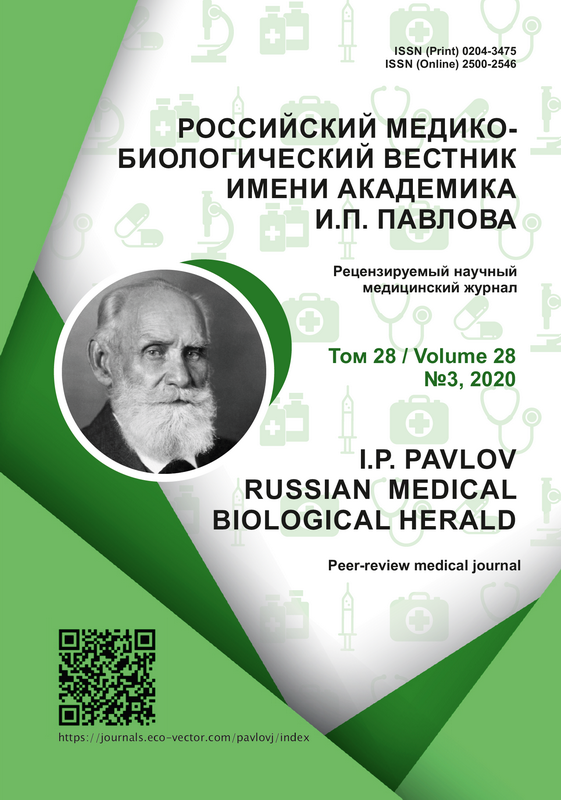Factors of biological nature in work of mobile teams of emergency medical care station on the eve of pandemics of new coronavirus infection (COVID-19)
- Authors: Bolobonkina T.A.1, Dementyev A.A.1, Shatrova N.V.1, Yankina S.V.1
-
Affiliations:
- Ryazan State Medical University
- Issue: Vol 28, No 3 (2020)
- Pages: 283-289
- Section: Original study
- Submitted: 14.04.2020
- Accepted: 04.08.2020
- Published: 19.10.2020
- URL: https://journals.eco-vector.com/pavlovj/article/view/33431
- DOI: https://doi.org/10.23888/PAVLOVJ2020283283-289
- ID: 33431
Cite item
Abstract
Aim. Determination of the actual spectrum of pathogenic microorganisms to which medical workers of mobile teams of emergency medical care (EMC) are exposed, and scientific justification of the class of the working conditions of this professional group in terms of the biological factor.
Materials and Methods. Data of the electronic journal of the automated «Ambulance Service» control system for infectious patients, and records of the register for infectious diseases among workers of the municipal emergency medical care station of Ryazan (300 medical assistants, 64 doctors) for 2016-2019 were used.
Results. The average amount of calls to patients with infectious pathology in 2016-2019 made 2178.5±221.3 per year. Most emergency calls were for intestinal infections, common cases were varicella, erysipelas, viral hepatites, tuberculosis infection, herpes zoster. The main load in servicing these calls fell on linear (from 63.7 to 77.4%) and pediatric (from 24.8 to 35.1%) teams; calls of resuscitation teams to patients of such profile were sporadic. The level of infectious morbidity of doctors made 0.78 cases per 100 doctors which is 1.2-fold higher than the level of medical assistants (t=3.79; р=0.0003).
Conclusion. The confirmed cases of diseases of the studied group of workers resulting from professional contacts with sources of infections of Group III pathogenicity permits to refer the working conditions of medical workers of mobile teams of emergency medical care stations to hazard Class II. However, a high probability for professional contact with high pathogenicity strains of group A influenza, HIV-1 and HIV-2, hepatitis C, D, E viruses belonging to Group II pathogenicity, and existence of the evident contacts with SARS-CoV-2, permit to raise the class of the working conditions to hazard Class III.
Full Text
About the authors
Tatyana A. Bolobonkina
Ryazan State Medical University
Author for correspondence.
Email: bolobonkina@bk.ru
ORCID iD: 0000-0003-1796-6023
SPIN-code: 2251-0350
Assistant of the Department of Disaster Medicine and Emergency Medicine
Russian Federation, RyazanAlexey A. Dementyev
Ryazan State Medical University
Email: dementiev_a@mail.ru
ORCID iD: 0000-0003-3038-5530
SPIN-code: 3797-9108
ResearcherId: T-2168-2018
MD, PhD, Associate Professor, Head of the Department of General Hygiene
Russian Federation, RyazanNatalya V. Shatrova
Ryazan State Medical University
Email: ysvetlana0903@mail.ru
ORCID iD: 0000-0003-0599-924X
SPIN-code: 2965-2704
MD, PhD, Associate Professor, Нead of the Department of Emergency Medicine and Safety
Russian Federation, RyazanSvetlana V. Yankina
Ryazan State Medical University
Email: ysvetlana0903@mail.ru
ORCID iD: 0000-0003-4400-8517
SPIN-code: 1541-1096
MD, PhD, Assistant of the Department of Emergency Medicine and Safety
Russian Federation, RyazanReferences
- Coronavirus (COVID-19). Available at: https://co-ronavirus-monitor.ru. Accessed: 2020 April 13.
- Abdollahi A, Mahmoudzadeh S. Microbial Profile of Air Contamination in Hospital Wards. Iranian Journal of Pa-thology. 2012;7(3):177-82.
- Karamova LM, Krasovsky VO, Akhmetshina VT, et al. Professional risk of health of medical employees of the sta-tion of ambulance medical care. Meditsina Truda i Ekologiya Cheloveka. 2017;(4): 28-35. (In Russ).
- Medvedeva OV, Litvinova NI, Komarov NV. Problems and health security personnel medical workers with average vocational education. I.P. Pavlov Russian Medical Biological Herald. 2012;(1):152-5. (In Russ).
- R 2.2.2006-05. 2.2. Guide on Hygienic Assessment of Factors of Working Environment and Work Load. Criteria and Classification of Working Conditions. Available at: http://docs.cntd.ru/document/ 1200040973. Accessed: 2020 April 13. (In Russ).
- Order Ministry of Health of the USSR of 29 December 1978 №1282 «O vvedenii izmenennykh form statisticheskoy otchetnosti uchrezhdeniy i organov zdravookhraneniya ob infektsionnykh zabolevaniyakh i utverzhdenii med-itsinskoy doku-mentatsii». Available at: http://docs.cntd.ru/document/ 551388153. Accessed: 2020 April 13. (In Russ).
- SP 1.3.2518-09 Bezopasnost’ raboty s mikroorga-nizmami III-IV grupp patogennosti (opasnosti) i vozbuditelyami parazitarnykh bolezney. Dopolne-niya i izmeneniya N1 k SP 1.3.2322-08. Available at: http://docs.cntd.ru/document/902165869. Accessed: 2020 April 13. (In Russ).
- Uspenskaya IV, Manukhina ЕV, Yurina SV. Introduction of internal control of quality and safety of medical activi-ties in healthcare organization. Nauka Molodykh (Eruditio Juvenium). 2017;5(4):427-39. (In Russ). doi: 10.23888/HMJ20174427-439
Supplementary files












